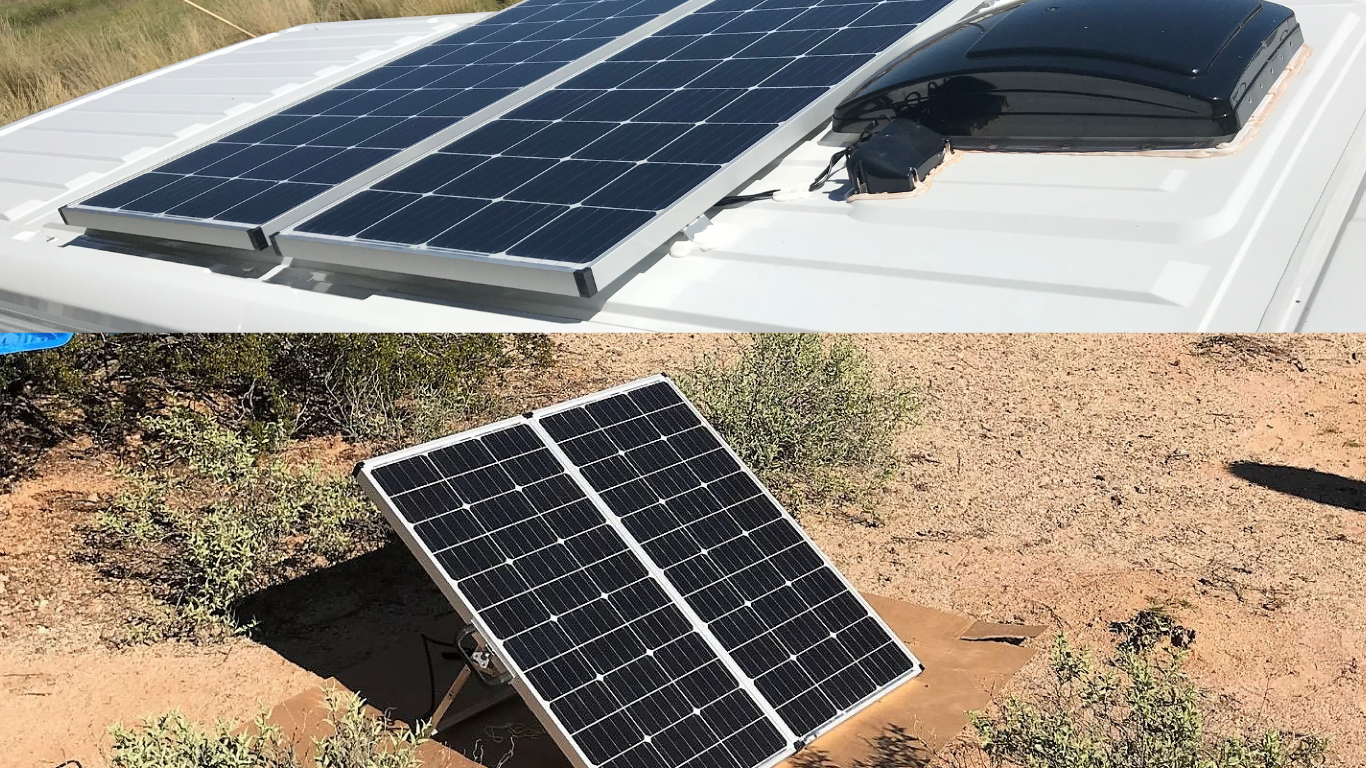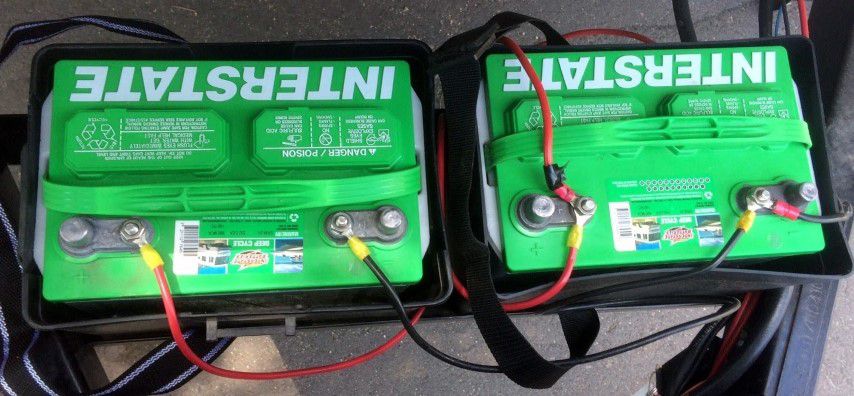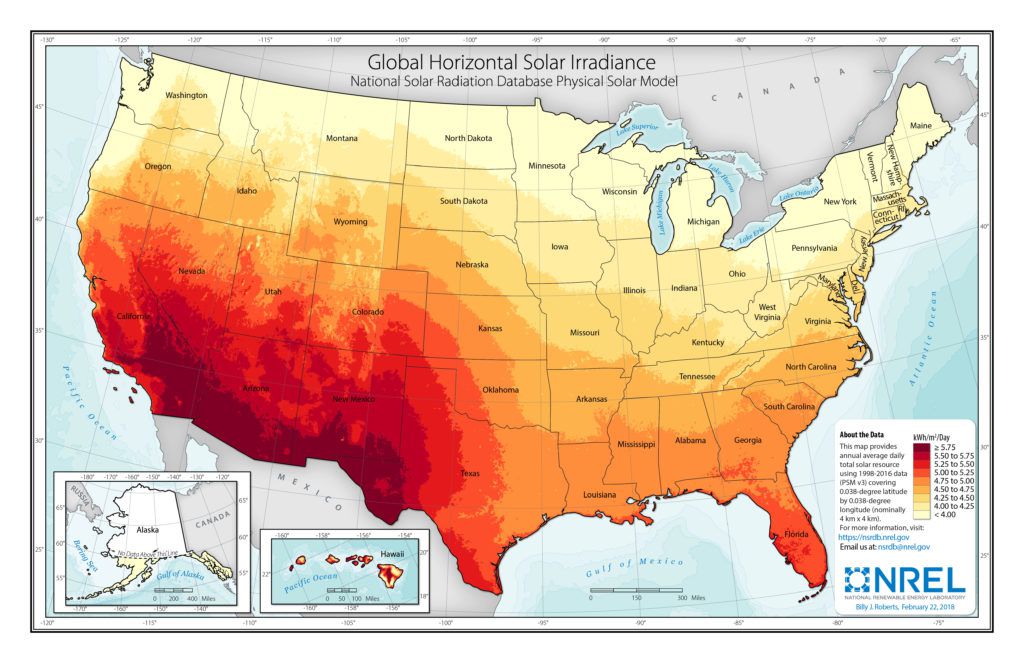

What Size Solar System Is Right For My RV?
If you don’t have a clue as to how many watts you need, or if a portable or rooftop system will work best. We hope this page helps. If you’re still confused, email us.
How to Size Solar for Your RV
To size a solar system for your RV you’ll need to estimate or calculate your power usage, factor in where, when, and how you’ll camp, and how your battery size plays into the system. Learn how to estimate how many watts you might need for your RV, or if a portable or rooftop solar system makes the most sense.
The size of your solar system can potentially be determined by the size of your RV, or your battery bank. We’ve added a quick and dirty solar sizing chart to give you an idea of how much you might need. But, keep in mind that if you have other equipment you like to use, like a blender or Instapot, the quick chart won’t be your best source of info.
Dive Deeper with our RV Solar Sizing, Three Ways to Estimate Electrical Usage
Quick RV Solar Sizing Chart
We’ve worked with solar for many years. It’s hard to figure out all the calculations if you’ve never been RVing. So we’ve put together this quick RV solar sizing chart to give you an idea of what to expect. It’s good to remember that solar can grow with your usage. As you get more comfortable you’ll likely want to use more devices, so you’ll need more solar.
We plan to greatly expand the options here. There are so many types of kits. These are simply recommendations to look at. There are kits that include combiner boxes for solar panels where expanding is easier, inverters, inverter/chargers, etc. Getting your first kit right will save you time and money when it’s time to go bigger. For now, if you’re still confused and want personal guidance please email – info@backcountrysolar.com.
For smaller RVs and truck campers you can easily start off with a smaller solar portable system or small roof-top solar system. Consider starting with at least a 90-watt portable solar system or a 100-watt rooftop mounted solar system. A 120-watt portable or 160-watt rooftop solar systems are most popular to start with.
Some We Recommend
We suggest starting with a little larger system. Go with a 120-watt to a 160-watt portable solar system or a 150 to 200-watt rooftop solar system. Make sure you get an expandable rooftop system so you can add more later.
Some We Recommend
This size RV is a little more tricky. Usage will vary depending on the user. We recommend starting with a 160-watt solar system or jumping up to 320-watts. A 200-watt is a good spot, but the system has two panels that will take up more space than if you were to get 2, 160-watt panels for 320. These kits are expandable. Since usage will vary you can add more later.
We’re in the same boat here. RV power usage varies so much between users. We recommend getting a system that is expandable. It’s very likely that you’ll want to look into solar kits with an MPPT charge controller as it’s more efficient. It’s a good idea to think of an MPPT charge controller on anything over 300-watts.
Batteries and Solar Work Hand-in-Hand
A quick note on batteries and how they work with solar.
When you’re RV camping off the grid, battery power is everything. Batteries power the electrical devices that you love to have every day. Vent fans, lights, water pumps, and even small refrigerators run off of battery power – this is also referred to as 12-volt power.


Bonus if you can spot what’s wrong here!
It’s important that we make sure that the batteries have enough energy to power our devices for however long we plan to use them. Going out for a couple of days and only needing lights and fans is far different than going out for a couple of days and using lights, fans, radio, computers, TV, etc.
Keeping your battery’s property charged will ensure that you have the power to run your devices as well as keep the batteries as healthy as they can be for longevity. Batteries aren’t cheap. Most RVers replace their lead-acid batteries every 2 to 3-years, but proper solar charging the batteries can make them last for 6 to 8-years. That’s 2X to 3X the life of your batteries and money in your pocket.
This is why solar on an RV is such a great option. If you do any type of boondocking or dry camping keeping your batteries charged up with both save you loads of battery replacements and give you the power to stay out longer.
What Size RV Solar System will work best for me?
To find the best size solar system for our RV we need to know these three things:
- How much power do you use?
- Where do you plan to do most of your camping?
- What time of year do you camp most frequently?
Daily RV Power Consumption
It’s important to understand how much power you use, or could potentially use, on a daily basis. By doing some rough calculations you can get very close to the solar system size, as well as the battery bank size, you’ll need. Here are a few ways you can find an average daily consumption.
Measure Battery Voltage
You can get a rough estimate of your usage by starting with a full battery and measuring the voltage of the battery after a day of camping. This requires that you have a battery bank large enough to handle a full day’s worth of usage in the RV.
Read more about how to estimate usage by measuring voltage. (Coming Soon)
Use a Kill-a-Watt Meter
A Kill-A-Watt meter is a device that you can put between your RV and shore power to see how many watts you’ve used. It’s a cheap and handy device.
Read more about how to use the Kill-A-Watt Method to find your RV electrical usage. (coming soon)
List Components and Usage for Calculation
For a deeper dive into finding your potential RV electrical usage, you can list out all your devices, define how long you plan to use them, and then calculate the usage. After you have this number you can then look at solar systems that can replace that amount per day. It’s basically how many of the solar calculators work.
Read more about calculating your solar needs (with a spreadsheet to get you started) (coming soon)
RV Camping Locations and Available Sun
If it’s not obvious, the amount of sun that is available will also factor in how much power you’re able to generate from solar panels. What might not be as obvious is that solar panels generate power even in cloudy conditions and there are levels of solar radiation. You can read more about how irradiance and how it’s factored in here – Solar Radiation Basics.
Camping in the American Southwest will be vastly different compared to camping in the American Northeast. The amount of sunlight that hits each area can vary based on terrain features and cloud coverage.


But also, don’t forget that terrain and weather play a factor in solar production. Maps like these can make you think that if you camp in the South you’ll have great solar power. While that can be true these areas can also have dense trees or large terrain features that can blog a good portion of the sun.
Average Solar Hours Per State
I took some sunshine data and put it in a table so you can get a sense of how many hours of sun hits your state on average.
But keep in mind this is an average for all year, and it’s for the entire state. It’s a good estimation if you like to camp in various spots. If you want more granular data I suggest you visit this site.
The Time of Year You Camp
The time of year you camp is also important. Most RVers camp during the summertime, maybe a little in spring and fall, but mainly in the summertime.
The quality of light changes with the seasons. Most winter in places is very cloudy, even in sunny spots like Bend, Oregon we see our fair days of clouds in the winter.
Winter times also come with shorter days. If you plan to do any camping in the “shoulder seasons” or winter time I would suggest you boost up your solar system by at least 30%. But it might be better to estimate how much solar you need by the amount of sunlight that will be available on the shortest and potentially cloudy days.
Here is a resource where you can do a bit more digging on how much sun is available in the US per month – https://www.nrel.gov/gis/solar-resource-maps.html
Bonus – Measure Your Roof
One important thing you should do before purchasing a solar kit is to measure the open space on your RV’s roof or boat to see what size panels will fit. Be sure not to position your panels where they will be shaded by antennas or vents. The easiest way to do this is to cut a piece of cardboard to the size of the solar panels you want to install and lay them out on the roof to find the best placement. Allow an inch on each side of the panel(s) for the mounting feet.

